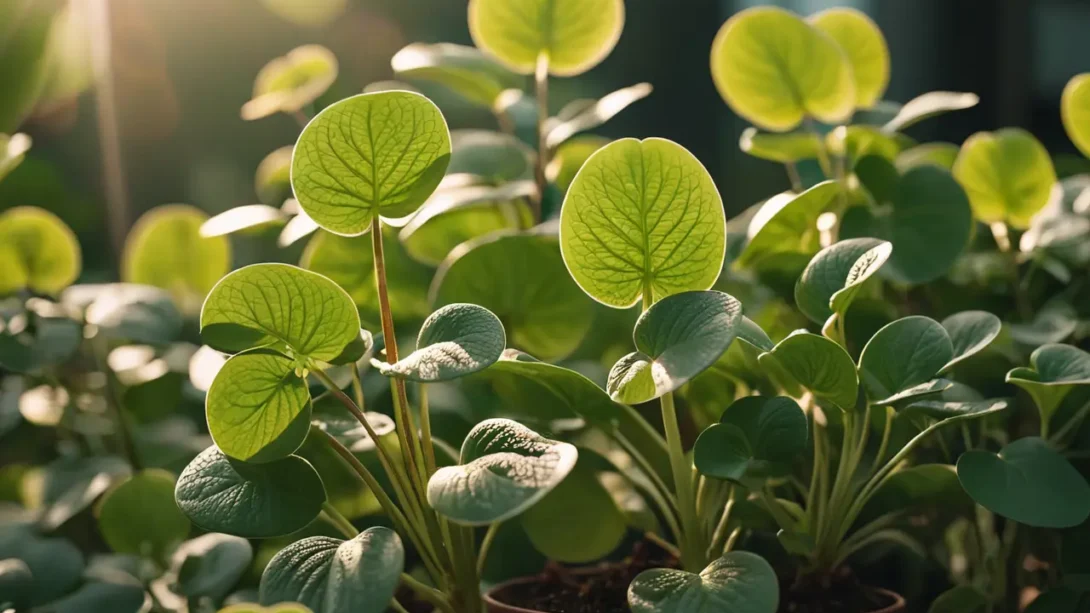Pilea peperomioides, commonly known as the Chinese Money Plant, is an eye-catching houseplant, beloved for its unique, round, coin-like leaves and ease of care. A symbol of prosperity and friendship, Pilea is not only a decorative addition to the home but also a popular choice for sharing among friends and family. This guide dives into the various methods of propagating Pilea, allowing even novice gardeners to expand their collection and share the joy of gardening.
Pilea Peperomioides
Characterized by its bright green, pancake-shaped leaves perched on long petioles, Pilea peperomioides has a distinctive appearance that captures attention. Originating from the Yunnan Province of China, this plant has a fascinating history and has spread worldwide through sharing cuttings among friends. Understanding its growth habits is key to successful propagation. Pilea enjoys bright, indirect light and a moderate watering schedule, thriving in well-draining soil and high humidity environments.
Before You Begin: Tools and Preparation
Before embarking on your propagation journey, gathering the necessary tools and preparing your workspace is essential. You’ll need:
- Sharp scissors or pruning shears, sterilized to prevent the spread of disease.
- Small pots or containers with drainage holes.
- High-quality, well-draining potting mix.
- Rooting hormone (optional) to encourage root growth.
Select a healthy parent plant that shows no signs of pests or diseases. A robust Pilea will produce the best cuttings or divisions for propagation.
Propagation Methods for Pilea
Division
One of the simplest methods to propagate Pilea is through division. This method is best performed during repotting when the plant has outgrown its current container. Here’s how to divide your Pilea:
- Gently Remove the Plant: Carefully take the parent plant out of its pot, being mindful not to damage the roots.
- Identify Natural Divisions: Look for natural separations between the stems or offsets that have their root systems.
- Separate with Care: Using your hands or a clean, sharp knife, gently separate the sections. Ensure each division has roots attached.
- Potting Divisions: Plant each division into its pot filled with fresh, well-draining potting mix. Water lightly to settle the soil around the roots.
Position your newly potted divisions in a location with indirect sunlight and maintain a consistent watering schedule, allowing the soil to partially dry out between waterings.
Rooting Stem Cuttings in Water
Propagating Pilea through stem cuttings in water is not only effective but also allows you to observe root development. Here’s the process:
- Select a Healthy Stem: Choose a healthy stem with at least two to three leaves. Cut just below a node (where leaves emerge from the stem) using sterilized scissors.
- Prepare the Cutting: Remove the lower leaves to expose the node, ensuring it will be submerged in water.
- Rooting in Water: Place the cutting in a glass or jar filled with water, making sure the node is underwater and the leaves are above water. Set in a bright spot without direct sunlight.
- Wait for Roots: Change the water every few days to keep it fresh. Roots should begin to appear within a few weeks.
Once the roots are a few inches long, the cutting is ready to be potted in soil. This method provides a visually gratifying experience as you watch the roots grow, offering a perfect blend of simplicity and engagement.
Rooting Stem Cuttings in Soil
Directly rooting stem cuttings in soil is a straightforward method that mirrors the plant’s natural growing conditions, promoting stronger root development from the start. Follow these steps to propagate Pilea using this technique:
- Prepare the Cutting: Select a healthy stem cutting from the parent plant, ensuring it has at least two to three leaves. Cut just below a node with sterilized scissors or shears.
- Prepare the Pot: Fill a small pot with a well-draining potting mix. Moisten the soil slightly before planting to provide a welcoming environment for the new roots.
- Plant the Cutting: Dip the cut end of the stem in rooting hormone powder (optional) to encourage root growth. Make a small hole in the center of the pot and insert the cutting, ensuring the node is buried in the soil.
- Care for the Cutting: Water gently to settle the soil around the cutting. Place the pot in a location with bright, indirect light. Maintain consistent moisture in the soil, but be careful not to overwater.
Roots typically develop within a few weeks, at which point you can begin to treat the cutting like a mature Pilea plant, gradually introducing it to the plant’s normal care routine.
Propagating from Offsets
Pilea peperomioides is known for producing offsets (baby plants) that grow from the base of the parent plant or emerge from the soil nearby. These offsets can be easily propagated to create new plants. Here’s how:
- Locate Offsets: Inspect the base of your Pilea plant for any small offsets that have formed. These should have their own roots or be attached to the parent plant by a small stem.
- Separation: If the offset has its roots, gently separate it from the parent plant using your fingers or a clean knife. If it’s connected by a stem, cut the stem as close to the parent plant’s base as possible.
- Potting Offsets: Plant the offsets in small pots filled with well-draining potting mix. Water lightly to help the soil settle around the new roots.
- Aftercare: Place the pots in a location with bright, indirect light. Keep the soil consistently moist, but not waterlogged, to encourage root development.
Offsets are an easy and efficient way to propagate Pilea, often resulting in a high success rate because the baby plants are already well on their way to establishing their own root systems.
Aftercare for Propagated Plants
After your Pilea cuttings or offsets have been potted, providing the right aftercare is crucial for their growth and development. Here are some tips to ensure your newly propagated plants thrive:
- Light: Place your Pilea in bright, indirect sunlight. Too much direct sun can scorch the leaves, while too little light can lead to leggy growth.
- Watering: Water when the top inch of soil feels dry to the touch. Overwatering is a common mistake that can lead to root rot, so ensure good drainage and avoid letting your Pilea sit in water.
- Humidity: Pilea plants prefer a humid environment. If your home is dry, especially in winter, consider using a humidifier or placing your plant on a pebble tray filled with water to increase humidity around the plant.
- Fertilizing: Feed your propagated Pilea with a diluted liquid houseplant fertilizer once a month during the growing season (spring through summer). Pause fertilizing in fall and winter as the plant’s growth slows.
Monitoring your plants for signs of stress or growth issues is essential during these early stages. New growth is a positive sign that your propagation efforts have been successful and that your Pilea is adjusting well to its new environment.
Troubleshooting Common Propagation Issues
Even with careful attention to detail, propagators may encounter some hurdles. Here are solutions to common issues that can arise when propagating Pilea:
- Rotting Cuttings: If your stem cuttings start to rot in water or soil, it could be due to poor water quality, too much moisture in the soil, or bacterial contamination. Ensure you change the water regularly for water propagation and use well-draining soil for soil propagation. Always use clean, sterilized tools when cutting.
- Slow or No Root Development: Lack of roots can result from inadequate lighting, incorrect temperature, or the cutting being too large. Ensure your cuttings are placed in a bright spot with indirect sunlight and at a comfortable room temperature. Cuttings should be 4-6 inches long for optimal rooting.
- Leaf Yellowing or Dropping: This could be a sign of overwatering, under-watering, or a sudden change in environment. Adjust your watering schedule as needed, and try to maintain a stable environment for your young plants.
Celebrating Your Propagation Success
Once your Pilea cuttings have rooted and are showing signs of new growth, it’s time to celebrate your propagation success. These young plants will gradually acclimatize to their new pots and start growing more vigorously. Sharing your propagated Pileas with friends and family can be a rewarding experience, spreading both greenery and joy.
FAQs
Q: How long does it take for Pilea cuttings to root?
A: Root development time can vary, but typically, stem cuttings root within 2-4 weeks in water and 4-6 weeks in soil. Offsets often have a head start since they might already have small roots when separated.
Q: Can I propagate Pilea at any time of the year?
A: While Pilea can technically be propagated year-round, spring and summer are the most optimal seasons due to the plant’s natural growth cycle and longer daylight hours.
Q: How do I know if my Pilea cutting has rooted?
A: For water propagation, you will see roots growing from the cutting. In soil, resistance when you gently tug on the cutting indicates that roots have formed. Offsets taken with roots are already on their way to establishing themselves.
Conclusion
Propagating Pilea peperomioides is a rewarding endeavor that allows gardeners to multiply their collection and share this delightful plant with others. Whether through division, rooting stem cuttings in water or soil, or propagating from offsets, each method offers its unique advantages. With the right aftercare, including proper light, water, humidity, and fertilization, your newly propagated Pileas will flourish, adding a touch of green elegance to any indoor space. Remember, patience and persistence are key to overcoming any propagation challenges, leading to a thriving indoor garden filled with lush Pilea plants.



